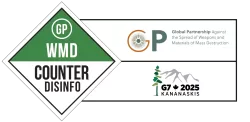Operation Denver
HISTORICAL NARRATIVE SERIES
BACKGROUND
In the early 1980s, the emergence of the HIV/AIDS epidemic marked the onset of a global public health crisis. Limited scientific knowledge at the time fuelled widespread fear, speculation and social stigma, particularly against vulnerable communities, including gay and black populations. Amid this climate, the Soviet Union launched a disinformation campaign to exploit these anxieties, strategically intensifying social and political divisions. The most infamous aspect of this campaign was the false narrative that HIV was a man-made virus engineered by the US government as a biological weapon, allegedly originating from the US Army’s Medical Research Institute for Infectious Diseases (USAMRIID) at Fort Detrick, Maryland.
Against the broader geopolitical tensions of the Cold War, this disinformation campaign sought to deepen mistrust in US institutions and stoke anti-American sentiment worldwide. Although scientists later confirmed that HIV originated from chimpanzees in Central Africa, the campaign had a lasting impact on public perception, further destabilising the US domestically and straining the already tense international environment.
THE OPERATION
In its most recent disinformation campaign, Russia employed several tactics, including:
- Flooding the information space. Overwhelming the OPCW with a large volume of materials containing false allegations. This is part of a broader tactic known as a firehose of falsehood.
- False Flags. Alleging that state actors have launched, or are preparing to launch, attacks against Russia using prohibited agents, often with the support of key member states.
- Misrepresentation of evidence.
- Claiming that issued patents or patent applications are evidence of nefarious activity (the issuance of a US patent does not make it legal to produce the patented device).
- Framing CBRN preparedness activities as evidence of offensive plans.
- Doctoring video evidence by sharing incomplete video footage to falsely suggest soldiers convulsing.
- Appeal to emotions. Sharing graphic images, videos, or textual descriptions to evoke feelings of disgust, fear and outrage.
OBJECTIVES AND RATIONALE
Linking the AIDS conspiracy theory to biological warfare aligned with the Soviet Union’s Cold War tactics aimed at undermining US credibility. By fostering the belief that the US government was responsible for creating and spreading the virus, the Soviet Union sought to exacerbate existing tensions within American society, particularly among marginalised communities, as well as between the US and other nations. This campaign successfully convinced some mainstream Western media outlets to propagate the disinformation, exploiting racial, political and ideological divisions. It tapped into pre-existing fears, such as the unethical behaviour of government institutions in scientific research (e.g. the Tuskegee syphilis experiment), weaponising those fears for geopolitical gain.
OUTCOMES AND IMPACT
Operation Denver had far-reaching consequences on both domestic and international fronts. Domestically within the US, the campaign intensified mistrust in government institutions, particularly among marginalised communities already bearing the brunt of social stigma and public health disparities. By linking HIV/AIDS to a deliberate government plot, the disinformation campaign fueled conspiracy theories that cast US health and military institutions as malicious actors. This perception further isolated affected communities, especially black and gay populations, aggravating existing social tensions and hampering early HIV prevention efforts by undermining public trust in health guidance.
KEY TAKEAWAYS
♦ Diplomatic Strain: The campaign further strained already tense US-Soviet relations during the Cold War. The spread of disinformation exacerbated mistrust between the superpowers, particularly as both governments accused each other of using the AIDS crisis for geopolitical gain. The mistrust fostered by the campaign hindered cooperation between the two countries, deepening the Cold War divide.
♦ Global Mistrust in Science and Medicine: The campaign contributed to global skepticism of the true origins of HIV/AIDS and fed into long-standing fears of government secrecy and misuse of science. This led to increased difficulty in combatting not just HIV/AIDS, but public health crises more broadly, as populations were more likely to question the intentions of governments and medical experts.
♦ Exacerbation of Social Divisions: By spreading disinformation across diverse media, including publications focused on black and gay communities, the Soviets fueled existing social tensions, particularly among those already marginalised by the epidemic. These efforts heightened public hysteria and suspicion towards institutions and contributed to stigmatising those most affected by the virus, including the LGBTQ+ community.
♦ Lessons Learned: This campaign shows how disinformation efforts exploit public health crises to further political or ideological agendas. Operation Denver displayed many of the same features that modern disinformation campaigns show, including unfounded claims of a lab origin and heightening of distrust in governments, particularly in the West.
